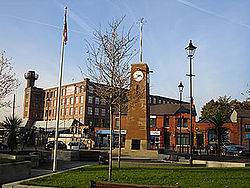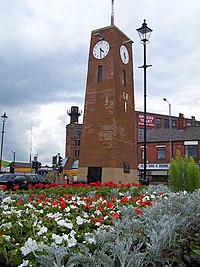Failsworth: Difference between revisions
Created page with "{{Infobox town |name=Failsworth |county=Lancashire |picture=Failsworth.jpg |picture caption=Failsworth Pole |os grid ref=SD895015 |latitude=53.5102 |longitude=-2.1575 |populat..." |
mNo edit summary |
||
| Line 15: | Line 15: | ||
|constituency=Ashton-under-Lyne | |constituency=Ashton-under-Lyne | ||
}} | }} | ||
'''Failsworth''' is a town in southern [[Lancashire]], within the conurbations in the south of the county | '''Failsworth''' is a town in southern [[Lancashire]], within the conurbations in the south of the county three and a half miles east-north-east of [[Manchester]] city centre and three miles south-south-west of [[Oldham]]. Failsworth lies within the orbital [[M60 motorway]], which skirts Failsworth's eastern boundary. | ||
Until the 19th century Failsworth was a small agricultural township linked, ecclesiastically, with the parish of Manchester.<ref name=teng>{{Harvnb|Lewis|1848|pp=206–209.}}</ref> Farming was the main industry of this rural area, with locals supplementing their incomes by hand-loom weaving in the domestic system. The introduction of textile manufacture during the Industrial Revolution facilitated a process of unplanned urbanisation in the area, giving rise to Failsworth as a mill town, marked architecturally by several large redbrick cotton mills. | Until the 19th century Failsworth was a small agricultural township linked, ecclesiastically, with the parish of Manchester.<ref name=teng>{{Harvnb|Lewis|1848|pp=206–209.}}</ref> Farming was the main industry of this rural area, with locals supplementing their incomes by hand-loom weaving in the domestic system. The introduction of textile manufacture during the Industrial Revolution facilitated a process of unplanned urbanisation in the area, giving rise to Failsworth as a mill town, marked architecturally by several large redbrick cotton mills. | ||
Latest revision as of 20:48, 8 January 2017
| Failsworth | |
| Lancashire | |
|---|---|
 Failsworth Pole | |
| Location | |
| Grid reference: | SD895015 |
| Location: | 53°30’37"N, 2°9’27"W |
| Data | |
| Population: | 20,680 (2011) |
| Post town: | Manchester |
| Postcode: | M35 |
| Dialling code: | 0161 |
| Local Government | |
| Council: | Oldham |
| Parliamentary constituency: |
Ashton-under-Lyne |
Failsworth is a town in southern Lancashire, within the conurbations in the south of the county three and a half miles east-north-east of Manchester city centre and three miles south-south-west of Oldham. Failsworth lies within the orbital M60 motorway, which skirts Failsworth's eastern boundary.
Until the 19th century Failsworth was a small agricultural township linked, ecclesiastically, with the parish of Manchester.[1] Farming was the main industry of this rural area, with locals supplementing their incomes by hand-loom weaving in the domestic system. The introduction of textile manufacture during the Industrial Revolution facilitated a process of unplanned urbanisation in the area, giving rise to Failsworth as a mill town, marked architecturally by several large redbrick cotton mills.
Failsworth's major landmark is the Failsworth Pole—a maypole which occupies the site of several former political poles. Daisy Nook is a country park at Failsworth's southern boundary with Droylsden. The village of Woodhouses is situated along Failsworth's eastern boundary. Notable residents of Failsworth have included the poet and writer Benjamin Brierley, who was born and raised by a weaving family.
History

The name 'Failsworth' derives from the Old English fegels worþ; it probably means an "enclosure with a special kind of fence".[2] Unmentioned in the Domesday Book of 1086, Failsworth does not appear in records until 1212, when the name was recorded as Fayleswrthe and the settlement was documented to have been a thegnage estate, or manor, comprising 4 oxgangs of land. 2 oxgangs with an annual rate of 4 shillings were payable by the tenant, Gilbert de Notton, to Adam de Prestwich who in turn paid tax to the King.[2][3] The remaining 2 oxgangs were held by the Lord of Manchester as part of his fee simple. The Byron family came to acquire all four oxgangs in the mid-13th century, and thus held the entire township. However, apart from a small estate in the township held by Cockersand Abbey, Failsworth was acquired by the Chetham family, which was then broadly sold to smaller holders.[3]
Little more than 300 years ago its population was over just 1,000. Farming was the main industry of the area with villagers supplementing their meagre incomes by hand-loom weaving until the advent of cotton and the Industrial Revolution.
In 1745 Bonnie Prince Charlie stayed overnight at the Bull's Head public house.[4]
In 1914 the regular Daisy Nook Easter Fair ceased due to the outbreak of war, but reopened in 1920. On 8 June 2007 a 1946 work by L.S. Lowry entitled "Good Friday, Daisy Nook" depicting the Easter Fair was sold for £3,772,000, the then highest price paid for one of his paintings at auction.[5] Another painting by Lowry from 1953 titled ‘Fun Fair at Daisy Nook’, sold for £3.4 million in 2011.[6]
Economy

Failsworth is a centre for the production of hats, manufacture began as a cottage industry before the firm of Failsworth Hats was set up in 1903 to manufacture silk hats. For a time the company operated from a factory near the former Failsworth Council offices and remains in the area to this day.[7] Today, Failsworth's main areas of economic activities are in electrical goods manufacture (such as Russell Hobbs) by Salton Europe (formerly Pifco Ltd, pre-2001), and plastic producers and distributors Hubron Limited. Many Failsworth residents work in Manchester, with many commuters choosing to live in the area because of its transport links which include the Metrolink tram service from Failsworth Metrolink station on the Oldham & Rochdale Line.
In the July 2007, the Tesco supermarket chain opened one of their 24-hour Extra branches on the banks of the newly regenerated wharf. The move has not been welcomed by small shop owners who have claimed that they have lost customers to the new store and may be forced to close.[8][9][10][11] It was intended that Tesco's arrival would be a catalyst to attract other stores, bars and restaurants to Failsworth.[12] The only other large store in the Failsworth boundary is a branch of Morrisons which is situated in the converted Marlborough Mill.[13]
Oldham Caravans, a subsidiary of Glossop Caravans have an outlet on Oldham Road in Failsworth.
Churches
- Church of England:
- The Holy Family
- St John's
- Woodhouses Church
- Baptist: Zion
- Independent / evangelical: Faithworks
- Methodist:
- Hope Methodist Church
- Roman Road Independent Methodist Church
- Pentecostal:
- New Life Church (Assemblies of God)
- Salvation Army: Failsworth Salvation Army Community Church
- United Reformed Church: Macedonia United Reformed Church
- Unitarian: Dob Lane Unitarian Chapel
- Roman Catholic: St Mary's
Sights about the town

A major landmark of the area is Failsworth Pole on Oldham Road. The first 'political pole' was erected in 1793 although a local historian suggests there were others before and that maypoles probably stood on the site for centuries. The pole that now stands on the site replaces one blown down in 1950.
Following a major restoration of the Pole, clock tower and gardens in 2006 a bronze statue of Benjamin Brierley was erected in the gardens.[14]
At the road junction of the A62 with Ashton Road West stands the cenotaph, built in 1923 in remembrance to over 200 Failsworth men who lost their lives in the First World War. Attendances at the cenotaph on Remembrance Sunday remain high, averaging around 2,000 people.[15] The annual Remembrance parade is led by 202 Field Squadron, RE (TA),[16] who are based in Failsworth. In June 2007 the war memorial was rededicated after at £136,000 makeover by the Failsworth War Memorial Steering Group, and opened by Colonel Sir John B. Timmins.
The Warwick Road Open Space at twelve and a half acres has been enrolled as a Queen Elizabeth II Field.
Outside links
| ("Wikimedia Commons" has material about Failsworth) |
References
- ↑ Lewis 1848, pp. 206–209.
- ↑ 2.0 2.1 Mills, A.D. (2003). A Dictionary of British Place-Names. Oxford: Oxford University Press. ISBN 0-19-852758-6. http://www.oxfordreference.com/views/ENTRY.html?entry=t40.e13974&srn=1&ssid=595401713#FIRSTHIT. (subscription required)
- ↑ 3.0 3.1 Brownbill & Farrer 1911, pp. 273–274.
- ↑ "Welcome to the award winning". Failsworth.info. Archived from the original on 19 February 2010. https://web.archive.org/web/20100219132326/http://failsworth.info:80/Failsworth/timeline.htm. Retrieved 13 February 2012.
- ↑ "Lowry work fetches record £3.8m". BBC News. 8 June 2007. http://news.bbc.co.uk/1/hi/entertainment/6735087.stm. Retrieved 16 January 2008.
- ↑ John Stevens (17 November 2011). "Lowry's Piccadilly Circus equals £5.6m record at Christie's | Mail Online". London: Dailymail.co.uk. http://www.dailymail.co.uk/news/article-2062534/Lowrys-Piccadilly-Circus-equals-5-6m-record-Christies.html. Retrieved 13 February 2012.
- ↑ Failsworth hats. failsworth-hats. Archived from the original on 17 January 2010. https://web.archive.org/web/20100117175236/http://www.failsworth-hats.co.uk:80/about-us.aspx. Retrieved 11 February 2010.
- ↑ "Tesco’s killing us say small traders". Oldham Advertiser (M.E.N. Media). 23 August 2007. http://menmedia.co.uk/oldhamadvertiser/news/s/1014297_tescos_killing_us_say_small_traders.html. Retrieved 13 February 2012.
- ↑ Conn, David (25 July 2007). "Supermarket sweep-up". The Guardian (London). https://www.theguardian.com/society/2007/jul/25/regeneration.supermarkets.
- ↑ Richardson, Anne (12 November 2003). "Tesco target Failsworth". Oldham Advertiser (M.E.N. Media). http://menmedia.co.uk/oldhamadvertiser/news/s/465574_tesco_target_failsworth. Retrieved 13 February 2012.
- ↑ Akbor, Ruhubia (6 February 2008). "Failsworth’s £30m new look". Oldham Advertiser (M.E.N. Media). http://menmedia.co.uk/oldhamadvertiser/news/s/1035401_failsworths_30m_new_look. Retrieved 13 February 2012.
- ↑ Conn, David (8 October 2008). "Buying into it". The Guardian (London). https://www.theguardian.com/society/2008/oct/08/regeneration.tesco.communities.
- ↑ "Chingford Store details". Morrisons. http://www.morrisons.co.uk/Store-finder/Store-Details/?type=qs&value=failsworth&recordid=1&lat=53.50467&lon=-2.17096. Retrieved 13 February 2012.
- ↑ J. McMahon and J. Crompton, The History of Failsworth Pole and the Ben Brierley Statue published June 2006.
- ↑ [1]
- ↑ http://www2.army.mod.uk/royalengineers/org/75regt/index.htm
- Brownbill, John; Farrer, William (1911). A History of the County of Lancaster: Volume 5. Victoria County History. ISBN 978-0-7129-1055-2.
- Lewis, Samuel (1848). A Topographical Dictionary of England. Institute of Historical Research. ISBN 978-0-8063-1508-9.
